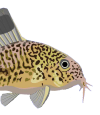Marcelo Fulgêncio Guedes Brito, Henrique Lazzarotto, & Erica Pellegrini Caramaschi. 2016. Atributos da história de vida de um cascudo de corredeiras de riachos de Mata Atlântica, Brasil. Biota Neotropica, 16(2), e20150068. On-line version ISSN 1676-0611. http://dx.doi.org/10.1590/1676-0611-BN-2015-0068
Interesting details for anyone who can get these and wants to spawn them:Brito et al. wrote: ABSTRACT
Spatial distribution, suitable spawning sites, and sexual dimorphism were investigated in armored catfish in the Macaé River from March 2004 to March 2005. Individuals of N. microps (n=290) were limited to fast-flowing stretches, and the distribution was related to ontogenetic development. Larvae in post-flexion occurred in the marginal vegetation, and adults only in gaps between boulders and stones in the river channel. Juveniles occurred in both environments. Spawns were found in the natural habitat in rapid stretches, with the eggs attached to the lower surface of stones in openings formed in the riverbed. The number of eggs per stone ranged from 62 to 375, with significant differences among the mean sizes of the eggs. Sexual dimorphism was noticed to N. microps. The anal and urogenital papillae are separated in males and merged in females and there is an epidermal growth along the pectoral-fin spine of males.
RESUMO
- Key words: Neoplecostomus microps; Loricariidae; distribution; spawn; sexual dimorphism
Distribuição espacial, locais favoráveis è desova e dimorfismo sexual foram estudados no cascudo no rio Macaé de março 2004 a março 2005. Espécimes de N. microps estiveram restritos a trechos de águas rápidas, e sua distribuição foi relacionada ao desenvolvimento ontogenético. Larvas em pós-flexão ocorreram somente na vegetação marginal e adultos somente em frestas entre rochas e pedras no canal do rio. Juvenis ocorreram em ambos ambientes. Desovas foram encontradas no ambiente natural em trechos de corredeira, com os ovos aderidos a superfície ventral de rochas em aberturas formadas com o leito do rio. O número de ovos/pedra variou de 62 a 375, com diferenças significativas entre os valores médios dos ovos. Dimorfismo sexual foi verificado em N. microps. As papilas anal e urogenital são separadas em machos e colabadas em fêmeas, e há uma projeção epidérmica na nadadeira peitoral de machos.
- Palavras-Chave: Neoplecostomus microps; Loricariidae; distribuição; desova; dimorfismo sexual
Sexing: Male N. microps show an epidermal growth along the pelvic-fin spine, forming a flap that projects toward the side of the body; this flap was observed in juvenile males 32 mm SL and larger. No females showed this epidermal expansion. Another difference observed between the sexes was in the genital area. In females, the anal and urogenital pores were very close, with the middle of the papillae merged, giving the appearance of a single opening. The males showed a separation between the anal and urogenital pores, featuring two distinct and defined openings. Males are generally larger than females. The smallest sexually-mature female and smallest male found were 58.0 mm and 64.0mm, respectively.
Temperature range: 11.5 - 25.5C (yes, that's 11.5C for low temp!)
Water conductivity from 12.2 - 73.2 µS/cm; dissolved oxygen from 7.45 - 10.78 mg/L.
Furniture: Adults and subadults are found in rapids flowing over stones on sandy or muddy substrates. Juveniles below 32mm SL are found almost exclusively in planted stream margins (in nature, mostly Zingiberaceae) with slower currents.
Breeding: Spawns were found in November and January, during the rainy season, exclusively in rapid stretches, in fast-flowing portions of the river associated with stones and boulders (i.e., headwaters).
Eggs were found attached to the undersides of stones, in cavities formed in the river bottom. Brito et al. (2016) suggest that adults choose stones as spawning sites based upon the presence of cavities or gaps (formed between the stone and riverbed) appropriate for the surface, size and position relative to the current. Adults seem to prefer large, flat stones over smaller rounder stones.
The number of eggs per stone ranged from 62 to 375. Eggs in different stages of development were found on the same stone, implying multiple spawning dates in the same pile of eggs. The egg colors ranged from yellow-gold, in eggs full of yolk in early development, to brown, in eggs with pigmented embryos in an advanced stage of development.





